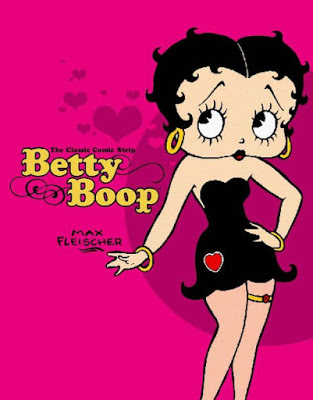 |
| Review by Lily Fierro |
One of the greatest challenges of the comic form arises when a comic strip must attempt to capture a well known persona from film and animation into a separate series.
For some characters, this can work.
However, for ones whose humor and personality stem from movement, stature, and voice, the transition of those characters and their worlds from a time-based medium to a print based medium can lead to an underwhelming product, for in a comic strip, the characters must have their eccentricities and scenarios represented in a static form, and this just cannot occur for characters whose fundamental allure comes from motion and/or sound, and sadly, such is the case with Betty Boop.
The Definitive Betty Boop collects the multiple comic strip forms of Betty Boop including Helen Kane’s short-lived series, The Original Boop-Boop-A-Doop Girl, and Max Fleischer’s Sunday strips and dailies of the Betty Boop series.
While the introduction by Brian Walker gives informative insight into the creation of Betty Boop and her multiple formations as a leading animation lady, a comic strip lead, and eventually a popular icon, it also implicitly prepares us to understand that by the time the comic strip began running, the animation series that brought Betty Boop to fame as a character (and the reason why I personally love her myself) had begun to wane because of the increased enforcement of the Hays Code in film by 1934, forcing Betty Boop’s antics to stray away from her more extraordinary scenarios such as lion taming in the circus and cave dwelling to find walrus-like ghosts singing Cab Calloway’s “Minnie the Moocher” and toward less salacious and suggestive situations overall.
Consequently, you enter The Definitive Betty Boop with an expectation that the comics will be far tamer than the animations of the early 1930s, and they most certainly are.
Unlike the early animations, the Betty Boop comics have her completely set in reality as a leading (and somewhat air-headed) bombshell in the film industry. She has love interests in leading men and spends much of her time working in film and nurturing her Aunt Tilly’s and her little brother Bubby’s careers in the entertainment business.
In the comic strip incarnation of Betty Boop, no longer do we see the exploring, wondrous, and joyous Betty Boop; we only now see her as an icon of Hollywood and how she uses that status in her daily life and career. Sure, the Betty Boop of the comic strip occasionally delivers comedic lines, but for the most part, her comedy comes only from acting like a dope and a ditz, and after 10 pages, that wears pretty thin.
To add further damage, the Betty Boop of the comic strip never leaves her scenario as an actress. She does not emerge as other characters with different lives, and she does not encounter and interact constantly with different characters in the series. As a result, from just the premise and the character construction alone, the Betty Boop of the comics lacks the spirit, energy, and simply fun of the animations.
Thus, with the combination of the weakness of the comic strip plot and the absence of Betty Boop’s signature voice and cadence and her wiggles and shakes as she walks and dances, the comic strips in The Definitive Betty Boop capture a duller, dimmer, and shallower Betty Boop who annoys more than entertains and fascinates.
With Labor Day coming up, I immediately think about one of my favorite Boston events that occurs over the weekend and my introduction to Betty Boop animations: the all night movie marathon at the Harvard Film Archive.
In its first year, the marathon featured pre-Hays code films and animations, showing the wildness, suggestiveness, and audaciousness of early 1930s Hollywood. The films all had a palpable freeing spirit and boldness about them, and the Betty Boop animations projected before and after the featured films carried on that independence and vivacity through every transition.
If only the comic strip began production a few years earlier; it may have caught that pre-Hays code bug and had that same liveliness, fearlessness, imagination, and overall delight for life.










































































































